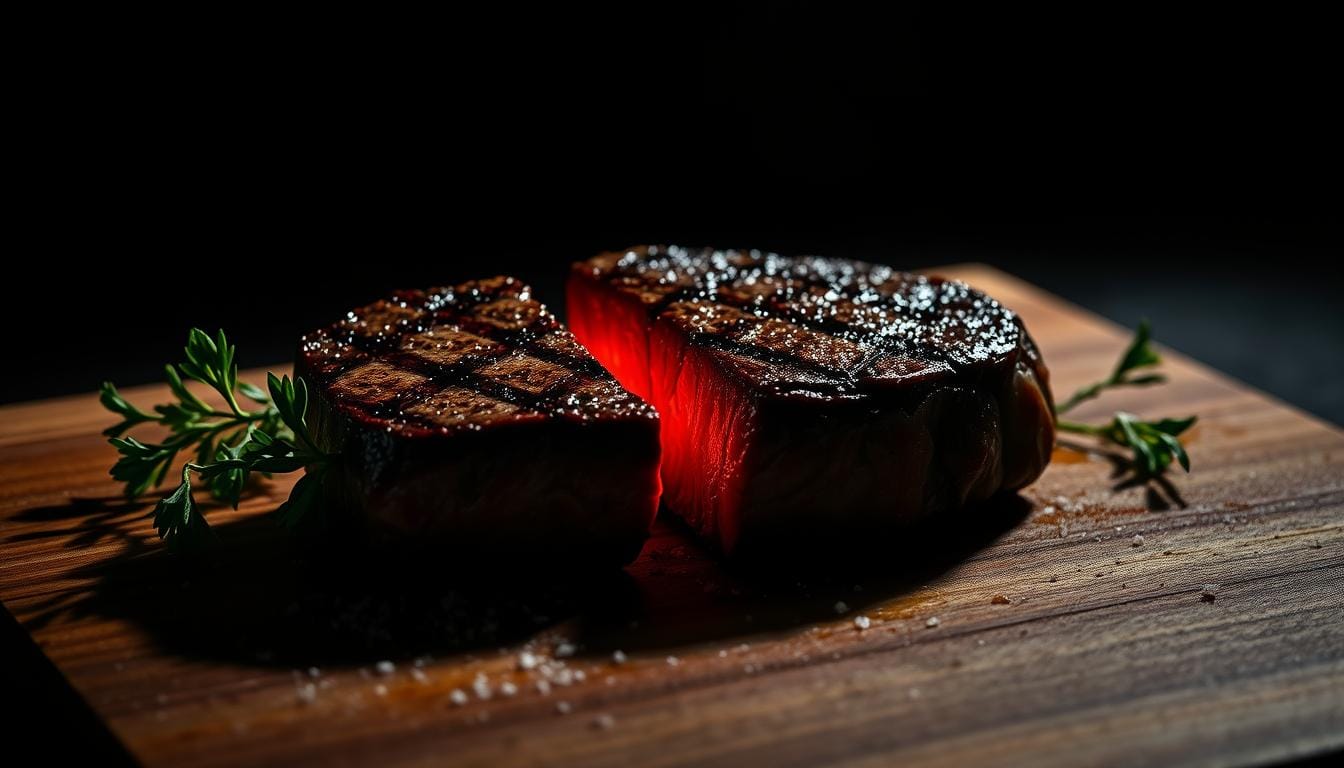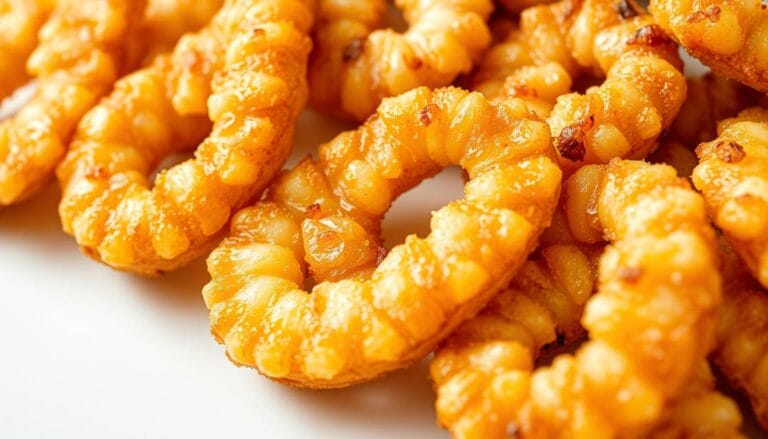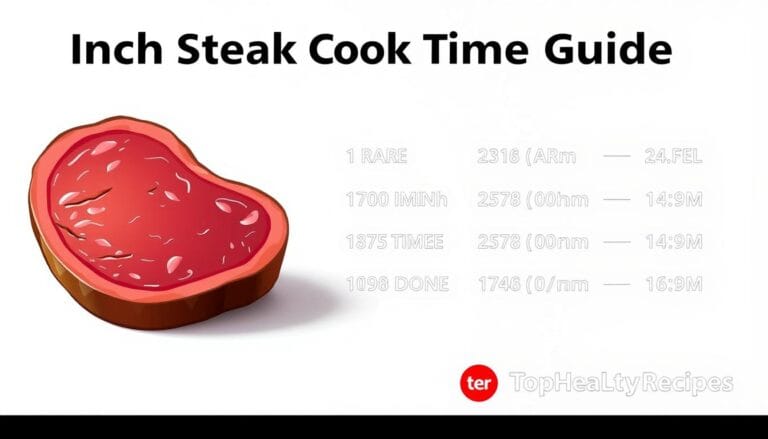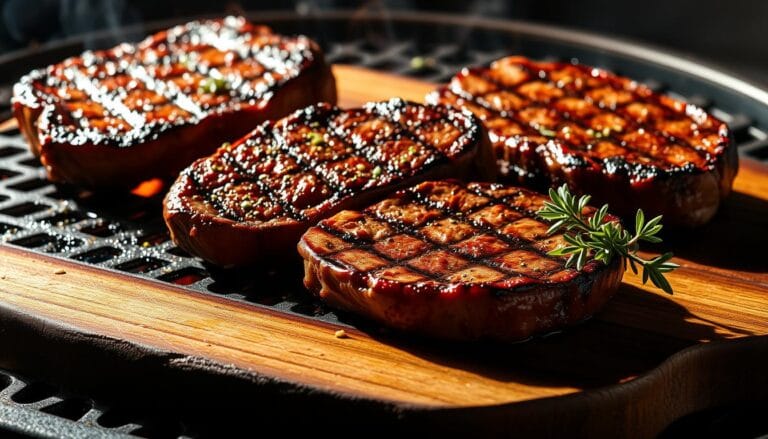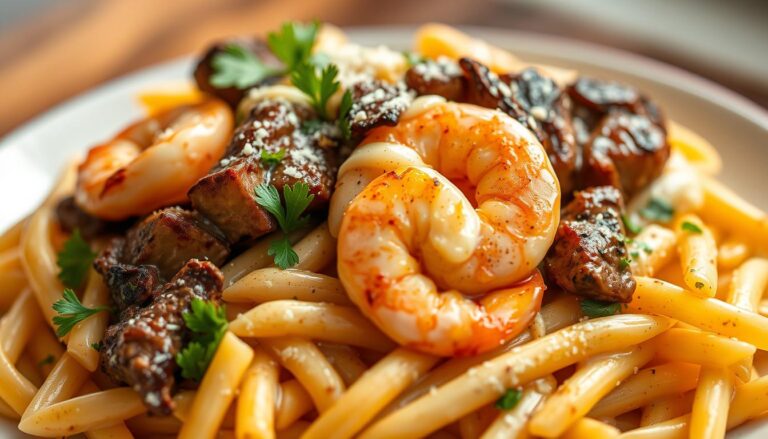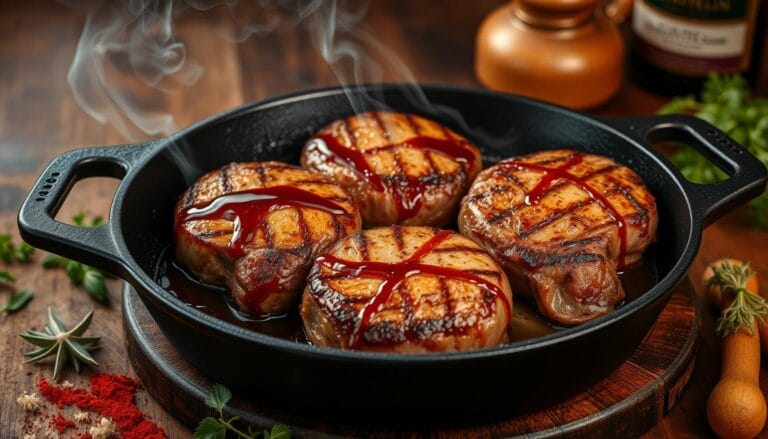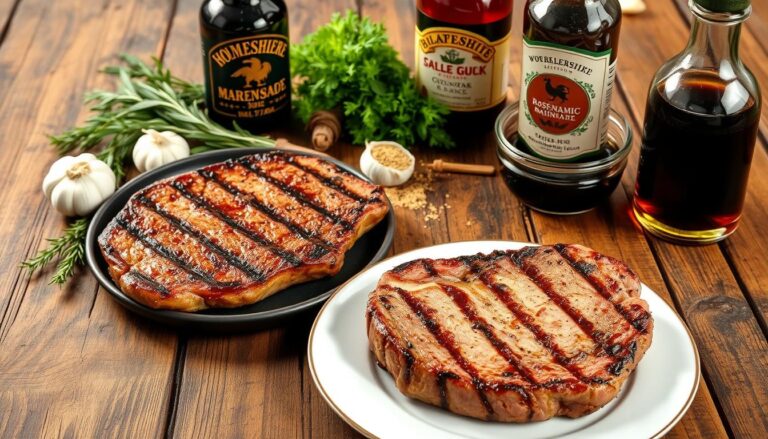What Temp Is a Medium Steak? The Exact Degrees for Perfection
Table of Contents
What Temp Is a Medium Steak? The Exact Degrees for Perfection
Many steak lovers aim for the perfect medium rare steak. It’s about finding the right temperature for a pink center and a warm red middle.
Cooking a steak to the right temperature can seem scary. But with the right tips, you can get it right. Knowing the exact degrees for medium rare is key for perfect steaks, whether you’re cooking at home or in a restaurant.
Using a meat thermometer and paying attention to visual signs are important. By mastering the medium rare temperature, you’ll wow your guests and meet your own cooking goals.
Key Takeaways
- Cooking a steak to the correct temperature is key for perfection.
- A meat thermometer is vital for the right temperature.
- Visual signs also show when a steak is medium rare.
- Learning the medium rare temperature boosts your cooking skills.
- Perfect steaks impress guests and meet your cooking standards.
Understanding Steak Doneness Levels
To truly appreciate a medium rare steak, knowing about steak doneness levels is key. Doneness affects a steak’s texture, flavor, and overall dining experience.
Common Terms for Steak Cooking
In professional kitchens, steaks are cooked to various levels. Each level has its own culinary term. These range from blue rare to well done.
Other terms include rare, medium rare, medium, and medium well. Knowing these terms helps you get your steak just right.
The doneness level is based on the steak’s internal temperature, color, and texture. For example, a rare steak has a warm red center. A well-done steak is fully cooked with no pink left.
How Doneness Affects Flavor and Texture
The cooking level of a steak changes its flavor and texture. Different cooking levels alter the meat’s proteins and fats. This creates different eating experiences.
A medium rare steak is tender and juicy with a rich flavor. On the other hand, a well-done steak is firmer and drier, with a more intense flavor.
The medium steak temperature offers a balance between tenderness and flavor. Knowing these differences helps you find your perfect steak.
What Is Medium Rare?
For steak lovers, getting a perfect medium rare is the top goal. The secret to a medium rare steak is its exact internal temperature. This temperature makes it different from other doneness levels.
A medium rare steak has a warm red center. It’s surrounded by a pinkish-red ring and a browned outside. This doneness is loved for its tenderness and flavor.
Definition of Medium Rare Steak
A medium rare steak is cooked to keep it juicy and tender. The ideal internal temperature range for medium rare is 130-135°F (54-57°C). This range is key for the perfect balance of tenderness and flavor.
Ideal Internal Temperature for Medium Rare
Knowing the ideal internal temperature is essential for a perfect medium rare steak. The temperature range of 130-135°F (54-57°C) is the best. Here’s a table showing different doneness levels and their temperatures:
| Doneness Level | Internal Temperature (°F) | Internal Temperature (°C) |
|---|---|---|
| Rare | 120-130 | 49-54 |
| Medium Rare | 130-135 | 54-57 |
| Medium | 140-145 | 60-63 |
By aiming for the right internal temperature, you can make sure your steak is perfectly medium rare. This improves the flavor and makes the steak tender and juicy.
The Science Behind Cooking Steak
Cooking steak is a delicate process. It involves understanding how heat changes the meat. You’re not just applying heat; you’re changing the steak’s texture, flavor, and quality.
The internal temperature of the steak is key. It determines the doneness. Different proteins in beef change at specific temperatures. This affects the steak’s texture and flavor.
How Heat Affects Meat
When heat is applied, several things happen. Proteins denature and then coagulate, changing the texture. Fat in the meat renders, adding flavor and tenderness. Moisture moves and some evaporates, affecting juiciness.
Protein denaturation is important. As proteins denature, they can become more or less tender. For example, collagen breaks down into gelatin at high temperatures, making the steak tender.
Temperature Control and Juiciness
Temperature control affects the steak’s juiciness. Cooking to the right internal temp steak keeps it moist. Overcooking can make the steak dry and tough.
To get a juicy steak, cook it to the correct temperature and let it rest. During rest, juices redistribute. This makes the steak tender and flavorful.
In summary, knowing the science behind cooking steak helps you make better choices. By controlling temperature and understanding heat’s effects, you can cook a juicy and flavorful steak.
The Perfect Cooking Temperature for Medium Rare
To get a perfect medium rare steak, you need to control the temperature well. The ideal internal temperature is between 130°F and 135°F (54°C to 57°C). But, when you take the steak out of the heat, aim for 128°F to 130°F (53°C to 54°C). This is because the steak will cook a bit more after it’s removed.
Recommended Fahrenheit Degrees
For a medium rare steak, the internal temperature is key. The United States Department of Agriculture (USDA) says to cook steaks to at least 145°F (63°C) for safety. But for medium rare, you can go lower. The best range is 130°F to 135°F. A meat thermometer is the best way to check the temperature.
| Doneness Level | Internal Temperature (°F) | Internal Temperature (°C) |
|---|---|---|
| Rare | 120-130 | 49-54 |
| Medium Rare | 130-135 | 54-57 |
| Medium | 140-145 | 60-63 |
Checking with a Meat Thermometer
Using a meat thermometer is key to knowing your steak’s internal temperature. There are many types, like instant-read digital thermometers and probe thermometers. To get a correct reading, put the thermometer in the thickest part of the steak, away from fat or bone.
Instant-read digital thermometers give quick readings and are great for the end of cooking. Probe thermometers let you monitor the temperature as the steak cooks.
Knowing the right temperature for medium rare and using a thermometer will help you cook a perfect steak every time.
Preparing a Steak for Cooking
Before you start cooking your steak, there’s important prep work to do. The quality of your steak and how you prepare it before cooking can greatly affect the final taste and texture.
Choosing the Right Cut of Steak
Choosing the right cut of steak is key for a perfect medium rare. Cuts like ribeye, strip, and filet mignon are great because of their marbling and tenderness. Marbling is the fat that’s spread throughout the meat, making it taste better and feel softer.
When picking a steak, look for ones with lots of marbling. These steaks are juicier and taste better. Also, a thicker steak cooks more evenly.
Importance of Resting Before Cooking
Letting your steak come to room temperature before cooking is a big help. By resting your steak at room temperature for 30-60 minutes, it cooks more evenly. This is key for a consistent medium rare.
Steaks cooked from cold can cook unevenly. The perfect internal temperature for medium rare is much lower than for beef medium well temp, which is between 145-155°F (63-68°C).
By focusing on these steps, you’ll cook a steak that’s not just perfect but also full of flavor.
Cooking Methods for Medium Rare Steak
To get a perfect medium rare steak, you need to know different cooking methods. The goal is to reach an internal temp steak of 130-135°F, no matter how you cook it.
Grilling: Tips for Great Results
Grilling is a favorite way to cook steak, giving it a smoky taste and a nice char. To grill a steak to medium rare, heat your grill to 450°F to 500°F. Sear the steak for 3-4 minutes on each side, depending on its thickness. Then, move it to a cooler part of the grill to finish cooking.
For gas grills, use the medium-high setting. For charcoal grills, make sure the coals are spread out and the grill is preheated with the lid on.
Pan-Searing vs. Grilling
Pan-searing is another great way to cook a medium rare steak. It helps create a good crust and can be topped with a tasty sauce. To pan-sear, heat a skillet, like cast iron, over high heat with a bit of oil. Sear the steak for 2-3 minutes on each side, then finish it in the oven if needed.
| Cooking Method | Advantages | Challenges |
|---|---|---|
| Grilling | Smoky flavor, nice char | Temperature control, flare-ups |
| Pan-Searing | Good crust, flavorful sauce | Risk of overcooking, mess |
Both grilling and pan-searing can make a perfectly cooked medium rare steak with an internal temp steak of 130-135°F. The most important thing is not to overcook the steak and to let it rest before serving.
Understanding Carryover Cooking
When cooking a steak to medium rare, it’s important to think about carryover cooking. This happens when the steak’s internal temperature keeps rising after it’s taken off the heat.
Impact on Final Temperature
Carryover cooking changes the steak’s final internal temperature. For a medium rare steak, you want it to be around 130°F to 135°F. But, the steak will keep cooking inside even after it’s off the heat. This can raise the temperature by another 5°F.
Key factors influencing carryover cooking include:
- The thickness of the steak
- The cooking method used (grilling, pan-searing, etc.)
- The temperature at which the steak is cooked
Timing Your Resting Period
The resting period is key. It lets the juices spread out in the steak, making it tender and tasty. For a medium rare steak, rest it for 5 to 10 minutes, depending on its thickness.
Here are some general guidelines for resting periods based on steak thickness:
| Steak Thickness | Resting Time |
|---|---|
| 1 inch | 5 minutes |
| 1.5 inches | 7-8 minutes |
| 2 inches | 10 minutes |
By understanding and accounting for carryover cooking, you can get a perfectly cooked medium rare steak. It will be tender and juicy.
Tips for Achieving Perfection
To make your steak perfect, you need to know about cooking and seasoning. First, let’s talk about how to bring out the steak’s natural taste.
Seasoning Your Steak for Flavor
Seasoning is key to a great steak. The right seasoning at the right time can change everything. For a 130-135°F medium rare, seasoning is critical.
- Use a lot of salt, like kosher or sea salt, because of their texture.
- Season right before cooking or hours ahead to let the salt soak in.
- Add spices like black pepper, garlic powder, or paprika to boost the flavor.
Using Butter and Herbs for Extra Flavor
Chefs use butter basting to add depth to steaks. This means melting butter with garlic and herbs like thyme and rosemary during cooking.
Butter basting not only adds flavor but also helps control the cooking. This ensures your steak is perfectly medium rare.
| Herb | Flavor Profile | Pairing Suggestion |
|---|---|---|
| Thyme | Earthy, slightly minty | Pairs well with garlic butter |
| Rosemary | Piney, aromatic | Complements rich, fatty steaks |
| Garlic | Pungent, savory | Enhances overall flavor |
By using these methods, you can cook a medium rare steak that’s both tasty and tender.
Troubleshooting Common Issues
Cooking the perfect medium rare steak can be tough. But, knowing how to fix common problems can help a lot. Even with great techniques, things can go wrong. Your steak might end up overcooked or undercooked. It’s key to know how to spot and fix these issues to get it just right.
Dealing with Overcooked Steaks
If your steak is too hot (145-155°F), it’s likely overcooked for medium rare. Signs include a firm feel, clear juices, and no pink color. To fix an overcooked steak, slice it thinly against the grain. Serve it with a sauce to add moisture and flavor.
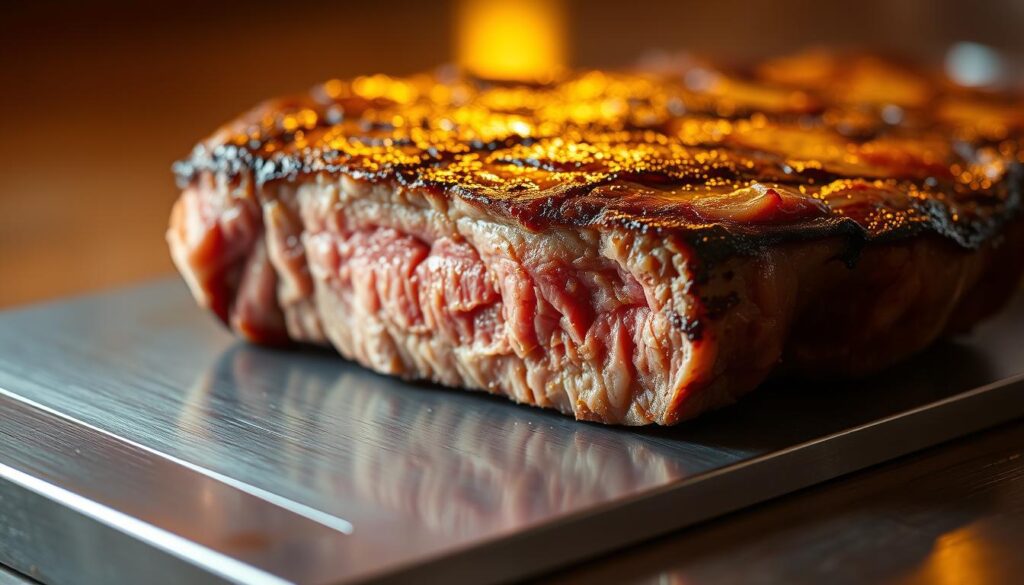
As Chef Gordon Ramsay said, “The key to cooking a great steak is to cook it with love and attention.”
“You can’t just throw a steak on the grill and expect it to be perfect. You need to understand the meat, the heat, and the timing.”
Signs Your Steak Is Not Medium Rare
If your steak feels soft or squishy, or has a cool center, it’s not medium rare. It might look dark purple or red. To fix it, you can heat it up for a bit or use a thermometer to check its temperature.
- Check for excessive softness or squishiness.
- Look for a cool center or dark purple coloration.
- Use a thermometer to ensure the correct internal temperature.
By spotting these signs and adjusting your cooking, you can get a perfect medium rare steak. With practice and patience, you’ll get better at cooking steak to the right doneness.
Safety Tips When Cooking Steak
Cooking steak to the right temperature is key for food safety. It’s as important as making it the way you like it. Finding the right balance between doneness and safety is essential.
Importance of Food Safety
Food safety is vital when cooking steak. The USDA gives guidelines for safe beef consumption. For medium rare, the internal temperature should be between 130°F and 135°F.
Using a meat thermometer is important, mainly for medium rare steaks.
Key food safety practices include:
- Proper storage of raw meat
- Avoiding cross-contamination with other foods and surfaces
- Keeping preparation surfaces clean
Recommended Cooking Temperature Guidelines
The USDA says intact muscle meats like steaks can be safely eaten at lower temperatures than ground beef. For healthy adults, cooking steak to medium rare (130-135°F) is safe. But, pregnant women, the elderly, and those with weakened immune systems might need to cook steaks to higher temperatures.
It’s important to know these guidelines and choose your steak’s doneness wisely.
By understanding steak safety and following food safety practices, you can enjoy your steak safely.
Cooking Steaks from Frozen
Cooking steaks from frozen can be surprisingly good. It’s becoming more popular because it can make steaks more even and less gray. This method can also reduce the gray band between the crust and the center.
When cooking steaks from frozen, you need to adjust cooking times and techniques. The secret to a perfect medium rare is knowing these adjustments. Frozen steaks cook more slowly, which helps in forming an even crust.
Impact on Cooking Times
Cooking times change a lot when steaks are frozen. Frozen steaks take longer than thawed ones. The exact time increase depends on the steak’s thickness and cooking method. Generally, add 50-100% more time for frozen steaks.
For example, a thawed steak might take 10 minutes to cook to medium rare. But a frozen steak of the same thickness could take 15-20 minutes. Always check the internal temperature to hit the 130-135°F mark for medium rare.
Adjusting for Medium Rare Results
To get a medium rare from frozen, use a two-stage cooking method. First, sear the steak at high heat to get a crust. Then, cook it at lower heat until it reaches the right temperature.
Here’s a simple guide to adjust your cooking:
| Steak Thickness | Cooking Method | Initial Searing Time | Finishing Temperature |
|---|---|---|---|
| 1-1.5 inches | Grilling | 3-4 minutes per side | 275°F |
| 1.5-2 inches | Pan-searing | 4-5 minutes per side | 300°F |
For more ideas on what to serve with your steak, try our shrimp on steak recipe.
Cooking steaks from frozen can be a game-changer. Knowing the right techniques is key to a perfect medium rare. So, what temp is a medium rare steak? It’s 130-135°F, whether fresh or frozen. With practice and patience, you’ll get delicious results every time.
Pairing Your Medium Rare Steak
Now that you’ve learned to cook a medium rare steak, let’s talk about how to make your meal better. The right side dishes and drinks can take your meal to the next level.
Recommended Side Dishes
Choosing the right side dishes can make your medium rare steak even better. Classic choices like creamed spinach, roasted potatoes, and sautéed mushrooms are great. They add flavor and make your meal more enjoyable.
- Creamed Spinach: A rich and creamy side that pairs well with the charred flavor of a grilled steak.
- Roasted Potatoes: Crispy on the outside and fluffy on the inside, they provide a satisfying contrast in texture.
- Sautéed Mushrooms: Earthy and savory, they complement the beefy flavor of the steak.
| Side Dish | Description | Flavor Profile |
|---|---|---|
| Creamed Spinach | Rich and creamy spinach dish | Garlic, creamy |
| Roasted Potatoes | Crispy outside, fluffy inside | Herbaceous, earthy |
| Sautéed Mushrooms | Earthy and savory mushrooms | Umami, earthy |
Wine Choices for Enhancing Flavor
The right wine can make your medium rare steak taste even better. Red wines like Cabernet Sauvignon, Malbec, and Syrah are perfect. They have tannins that work well with the steak’s proteins and fats.
“A good wine can elevate the dining experience by complementing the flavors of the meal.”
If you don’t like wine, you can try craft beers or artisanal sodas. They can also pair well with steak.
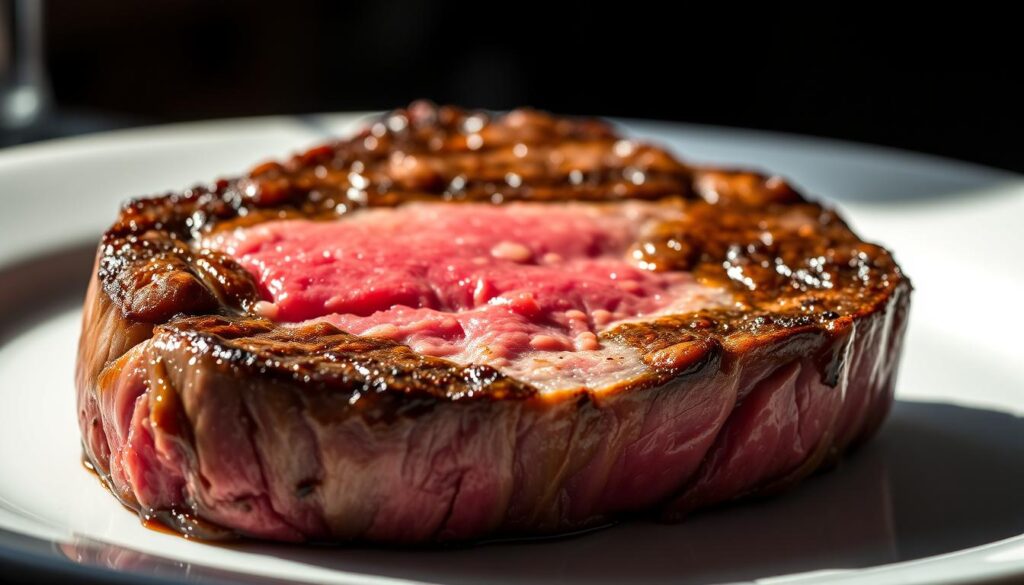
Storing Leftover Medium Rare Steak
Storing leftover medium rare steak needs careful handling. This is because it has more moisture than steaks cooked to a higher temperature, like beef medium well temp. This makes storing and reheating it more delicate.
Proper Refrigeration Techniques
First, let your leftover medium rare steak cool down to room temperature. This stops bacterial growth. Then, wrap it tightly in plastic wrap or aluminum foil to keep moisture in.
You can also use airtight containers. Refrigerate the steak at a temperature below 40°F (4°C) within two hours of cooking.
Reheating Tips Without Overcooking
When reheating, do it gently to avoid overcooking. Use the oven at a low temperature (around 200°F or 90°C). Warm the steak until it reaches your desired temperature.
Another good method is sous vide reheating. It lets you control the temperature precisely. For thicker cuts, try the reverse sear method.
Avoid microwaving, as it can make the steak tough and unevenly heated. By following these tips, you can enjoy your medium rare steak again without losing much quality.
Frequently Asked Questions
Many people wonder about the perfect temperature for a medium rare steak. Achieving this requires careful attention. But there are other questions too. Let’s explore some common ones to help you cook steak like a pro.
Checking Doneness Without a Thermometer
Without a thermometer, you can use other methods to check if your steak is done. The “finger test” is one way. It compares the steak’s firmness to your palm’s flesh. For medium rare, it should feel like the base of your thumb.
You can also look at the steak’s color. But remember, these methods aren’t as reliable as a thermometer.
Cooking Steak in the Oven for Medium Rare
Cooking steak in the oven can also get you a perfect medium rare. Reverse searing is a good technique. It starts with a low oven temperature and ends with a high-heat sear.
Using the broiler can also give you a crispy crust. For medium rare, the internal temperature should be between 130-135°F. Always use a thermometer to check the temperature. Adjust cooking time based on steak thickness and oven performance.
Other questions include how steak thickness affects cooking time and how to adjust for different cuts. For thicker steaks, cooking time will be longer. Different cuts might have their own ideal temperatures. When cooking for guests, use a thermometer to ensure each steak is cooked just right.
Conclusion
Now you know how to cook a medium rare steak. It’s all about paying attention to temperature. The perfect steak is between 130-135°F inside.
Key Takeaways for Medium Rare Success
To cook steaks perfectly, use a meat thermometer for accuracy. Knowing about carryover cooking and adjusting rest time is key. These skills will make your steak tender, juicy, and full of flavor.
Continuing Your Steak Cooking Journey
Keep improving your steak cooking by trying different cuts and flavors. With practice, you’ll get better at cooking steaks just right. So, what temp is a medium rare steak? It’s about being precise and controlling the heat.
FAQ
How can you tell steak doneness without a thermometer?
Can you cook steak in the oven for medium rare?
What temp is a medium rare steak?
What is the internal temp steak for medium?
What is the beef medium well temp?
How do you achieve the perfect medium rare temperature?
What are some common issues when cooking steak to medium rare?
How do you reheat leftover medium rare steak without overcooking it?
What are some recommended side dishes and wine pairings for medium rare steak?
For more cooking tips, stay connected with us. We also recommend the cookbook Skinnytaste Simple: Easy, Healthy Recipes with 7 Ingredients or Fewer
For more Recipes about Steak ?
Did You try our recipe ?
There are no reviews yet. Be the first one to write one.
